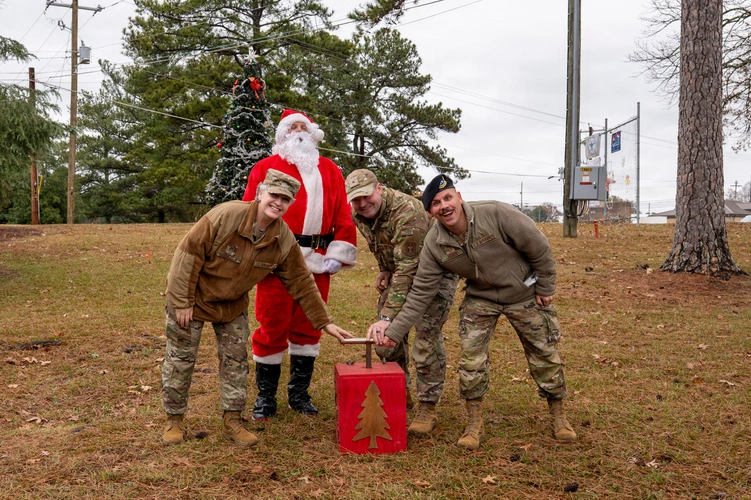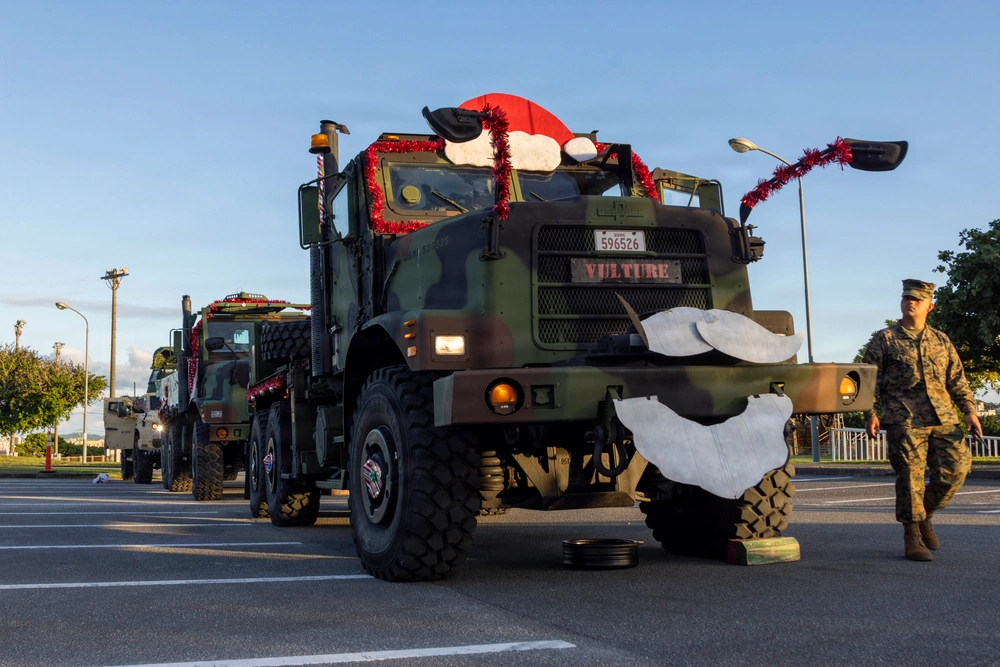- Details
- Hits: 42

GEORGIA, UNITED STATES, (December 5, 2025): Leadership from the 94th Airlift Wing presses a button to light a Christmas tree at Dobbins Air Reserve Base, Ga. The Tree Lighting Ceremony is an annual morale event that celebrates the year, holiday cheer and camaraderie. (Photo by Staff Sgt. Gage Daniel)
- Details
- Hits: 45

NAPLES, ITALY, (December 4, 2025): U.S. Naval Support Activity (NSA) Naples, Italy celebrates annual holiday Tree Lighting Event in Gricignano, Aversa, Italy. The event, often considered as an "unofficial" kick-off to the holiday season was attended by Capt. John Randazzo, NSA Naples, Italy Commanding Officer, Vittorio Lettieri, Mayor of Gricignano, and over 2,000 service members and families from various commands including NATO. NSA Naples is an operational base, home to over 50 commands and 8,500 personnel, providing crucial support for U.S. and allied forces across Europe, Africa, and the Central Command's areas of responsibility. From air and port operations to force protection and logistics, the base ensures combat readiness while prioritizing the well-being of service members and their families. (U.S. Navy photo by Mass Communication Specialist 1st Class Sean Rinner)
- Details
- Hits: 74

PYEONGTAEK, GYEONGGIDO [KYONGGI-DO], SOUTH KOREA, (December 4, 2025): USAG Humphreys - Camp Humphreys Downtown Plaza is lit up during the Camp Humphreys Tree Lighting Event on Camp Humphreys, South Korea, Dec. 5, 2025. The garrison’s Directorate of Family and Morale, Welfare, and Recreation hosted the event to spark the holiday spirit among the Humphreys community. (U.S. Army photo by Pfc. Seu Chan)
- Details
- Hits: 91

VICENZA, ITALY, (November 30, 2025): U.S. Soldiers assigned to U.S. Army Southern European Task Force, Africa (SETAF-AF), perform a series of physical events during the Santa’s bootcamp themed Lions Legacy competition at Caserma Del Din, Vicenza, Italy, Dec. 1, 2025. Among other events, the bootcamp consisted of physical activities such as dragging a sleigh, lifting heavy toy bags and low crawling through a chimney, all meant to simulate Santa's Christmas workout routine. SETAF-AF personnel conducted the gauntlet as part of the Lions Legacy monthly series, focused on enhancing warfighter readiness through unit cohesion and sustained physical fitness. (U.S. Army photo by Cpl. James Robinson)
- Details
- Hits: 115

OKINAWA, JAPAN, (December 3, 2025): U.S. Marines with Headquarters Battalion, 3rd Marine Division, prepare a holiday parade for departure at Camp McTureous, Okinawa, Japan. Marines from III Marine Expeditionary Force supported Marine Corps Community Services by escorting Santa around the installation. (U.S. Marine Corps photo by Sgt. Jackson Ricker)
- Details
- Hits: 140

GREAT LAKES, ILLINOIS, UNITED STATES, (December 5, 2025): Sailors pose for a picture with Santa during a Holiday Extravaganza event hosted by Naval Station Great Lakes Morale, Wellness, and Recreation at the Epicenter. The event was open to service members and their families and created a festive environment for service member’s children with holiday workshop crafts, free movies and bowling, pictures with Santa and free cookies and hot chocolate. (U.S. Navy photos by Mass Communication Specialist 2nd Class Evan Mueller)
- SOLDIERS AND POLISH COMMUNITY CELEBRATE 2025 CHRISTMAS TREE LIGHTING CEREMONY
- HEGSETH, WIFE, DEDICATE INAUGURAL PENTAGON CHRISTMAS TREE TO FAMILIES OF SERVICE MEMBERS
- AMERICAN HOLIDAY FESTIVAL 2025
- SERVICE MEMBERS, VOLUNTEERS, FAMILIES PREPARE BUNDLES FOR OCD25
- MARINES WITH CAMP BLAZ COLLECT TOYS FOR TOYS FOR TOTS 2025
- MCCS CAMP PENDLETON HOSTS THE 2025 TREE LIGHTING CELEBRATION


